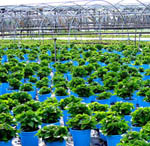Profiting from invasive plants: the challenge of controlling the horticultural industry
 Plant nursery. Image credit, Colin Gregory Palmer .From purple loosestrife to salt cedar to hydrilla, over 5,000 exotic plant species have established in the wild in the United States. It has been estimated that invasive plants cost an estimated $35 billion per year nationally in crop and livestock losses, property damage, eradication efforts and reduced agricultural exports. Their threat to biodiversity is second only in rank to habitat loss.
Plant nursery. Image credit, Colin Gregory Palmer .From purple loosestrife to salt cedar to hydrilla, over 5,000 exotic plant species have established in the wild in the United States. It has been estimated that invasive plants cost an estimated $35 billion per year nationally in crop and livestock losses, property damage, eradication efforts and reduced agricultural exports. Their threat to biodiversity is second only in rank to habitat loss.
But “what do you do when one person’s conservation problem is another person’s livelihood?”, as Conservation Magazine  A highly invasive broom (Genista) in California... and gardening favorite. Credit, PlantRight.asked in 2002. For example, in California, the horticulture industry contributes an estmated $17 billion to the state economy and accounts for over 212,000 jobs.
A highly invasive broom (Genista) in California... and gardening favorite. Credit, PlantRight.asked in 2002. For example, in California, the horticulture industry contributes an estmated $17 billion to the state economy and accounts for over 212,000 jobs.
A paper recently published in the journal Biological Invasions is the latest contribution to a 20-year long brainstorming on this difficult question. Researchers from the University of Minnesota profile the horticultural industry to determine the most judicious pressure points to abate this environmental issue while acknowledging the sector’s economic interests.
The authors conclude that “the solution for controlling the spread of invasive plants in the horticultural industry will necessarily involve a public effort that develops consumer awareness of invasive species while promoting interesting, fun alternative plant choices to effectively change demand.”
“In the course of looking at this whole industry, it became evident that the consumers can play a key role in the control of invasives with their purchasing power," said co-author Jennifer Drew. Today, the sector is so convoluted and its actors so dispersed that there is no one convenient node where to intervene so as to affect the entire supply chain.
The core of the paper is an intricate flow chart that illustrates the ornamental plants distribution channel. Its agents include breeders, explorers, collectors, producers, brokers, distributors, packet seed companies, wholesale growers, retailers, and gardeners. The way these professionals collaborate fluctuates. Furthermore, many can simply be bypassed in the release-circuit of a new cultivar to the market.
State and federal regulations have been developed to attempt to halt the spread of invasive species. In addition to the federal noxious weeds list, states have computed their own lists since plant species can be invasive in one region and not in another.
The prohibited weeds are most often ones that have an agricultural impact— habitat impacts are being largely overlooked. And the restrictions that apply to those listed species vary greatly in degree creating much confusion. Finally, this patchwork of lists is poorly enforced as government initiatives mainly tackle eradication and restoration.
A number of factors make the horticultural industry an increasingly important pathway for the spread of invasive plants: the accelerated speed of new introductions, the technological revolutions, and market innovations. Unfortunately, plants that sell well happen to share many characteristics with potential problem plants, such as heat tolerance or wide adaptability.
In 2001, a promising step occurred with the drafting of Voluntary Codes of Conduct for Nursery Professionals at the Missouri Botanical Garden workshop on plant invasions. Yet Drew and study co-authors doubt that self-regulation alone will curtail the propagation of invasives:
“Most importantly, given that firms are motivated by profit, self regulation—without imposing sanctions or other formal/informal means of coercion—will fail because it does not address the moral hazard problem where agents tend to act in their self interest when there is a low risk of penalty or loss of reputation.” They suggest the way out of this impasse is to focus on educating and involving the consumer.
However, not everyone shares this pessimism on the potential for self-regulation. “It’s too bad that the researchers didn’t get an update on some of the programs they mention. There are ways to address the complexity of the industry.”
Christiana Conser is referring to the PlantRight campaign she manages which brings together environmental groups and representatives from the California nursery industry to devise a method to prevent invasive plants introduction through horticulture.
It was launched in 2005 as a local follow-up to the Saint Louis Declaration and its generic voluntary codes. After analyzing the California network of 13,000 retailers, growers, and wholesalers, Conser’s nonprofit employer, Sustainable Conservation, identified 50 businesses to partner with—25 growers and 25 retailers—that would enable PlantRight to encompass 80% of the plants sold in California. Getting them on board is this year’s goal.
“On the one hand, I think it’s moving painfully slow; but on the other hand, the benefit is that we are building trust between the various constituencies. It is the most constructive route. Regulation can be divisive and it’s not so simple to enforce”, said Doug Johnson, executive director of the California Invasive Plants Council that also sponsors the PlantRight campaign.
The program, still in its infancy, is gaining momentum. Monrovia, a leading grower nationwide, which sits on the committee, withdrew salt cedar and russian olive from its inventory and tweaked its sales application software so it does not allow orders to be placed for plants that are classified as invasive in a particular part of the country.
Another project PlantRight is working on is a voluntary weed risk assessment program—a protocol to screen new plants for their invasive tendencies. Nicholas Staddon is responsible for all the new product development at Monrovia:
“I have the best opportunity to prevent invasive plants from getting into our mix. Just recently I was offered from a Dutch grower a magnificent Cortaderia. Cortaderia jubata, along the coastline, is very invasive. We grow some other cultivar named Cordetaria selloana ‘Ivory Feathers’. I asked this man if the seed was sterile. He said he didn’t know. So we passed on the plant.”
Staddon’s company joined PlantRight to be part of the conversation. “The industry wants to be sure that if there is legislation put into place, that it is fair and reasonable, that it’s not draconian”, said Staddon. He would rather be proactive on this issue than have the legislation imposed on him in a top-down fashion.
Meanwhile, organizations like the California Invasive Plant Council have also been focusing on educating the consumer. For example, since 2004, about 240,000 copies of its Don’t Plant a Pest! booklet, which underlines possible alternatives for invasive species, have been printed. However Christina Conser points out,
“A lot of home gardeners don’t have a real in-depth botanical knowledge and taxonomic experience. So trying to identify basic plants in a nursery can be really difficult. It seems easier to go to the source of the problem and remove the plants from the market.”
--by Cécile LePage
Drew, J., Anderson, N., & Andow, D. (2010). Conundrums of a complex vector for invasive species control: a detailed examination of the horticultural industry Biological Invasions DOI: 10.1007/s10530-010-9689-8




 Economics
Economics
Reader Comments